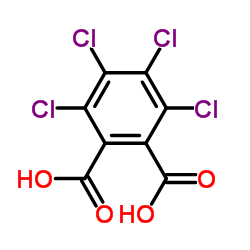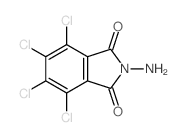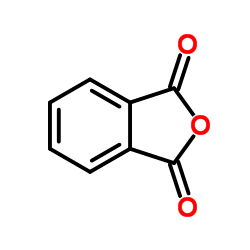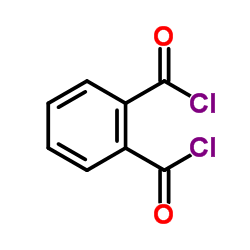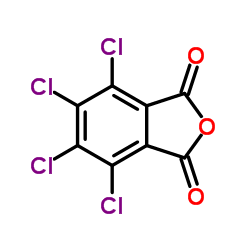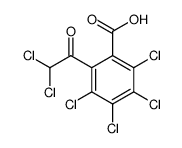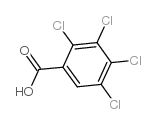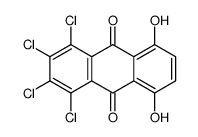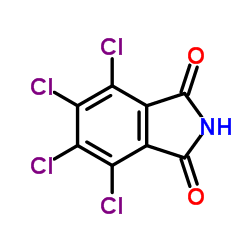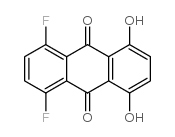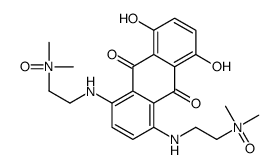632-58-6
| 中文名 | 3,4,5,6-四氯-1,2-苯二甲酸半水合物 |
|---|---|
| 英文名 | Tetrachlorophthalic Acid |
| 中文别名 |
四氯邻苯二甲酸半水合物
四氯酞酸半水合物 四氯邻苯二甲酸 |
| 英文别名 |
3,4,5,6-Tetrachlorophthalic acid
MFCD00053309 EINECS 211-181-2 Tetrachlorophthalic acid 1,2-Benzenedicarboxylic acid, 3,4,5,6-tetrachloro- |
| 密度 | 1.9±0.1 g/cm3 |
|---|---|
| 沸点 | 439.1±45.0 °C at 760 mmHg |
| 熔点 | 98°C |
| 分子式 | C8H2Cl4O4 |
| 分子量 | 303.911 |
| 闪点 | 219.4±28.7 °C |
| 精确质量 | 301.870728 |
| PSA | 74.60000 |
| LogP | 3.83 |
| 外观性状 | 白色结晶粉末 |
| 蒸汽压 | 0.0±1.1 mmHg at 25°C |
| 折射率 | 1.657 |
| 储存条件 | 储存于阴凉、通风的库房。远离火种、热源。包装密封。应与氧化剂、碱类、食用化学品分开存放,切忌混储。 |
| 稳定性 | 远离氧化物。 |
| 水溶解性 | Sparingly soluble |
| 分子结构 | 1、 摩尔折射率:59.69 2、 摩尔体积(m3/mol):162.2 3、 等张比容(90.2K):475.0 4、 表面张力(dyne/cm):73.3 5、 极化率(10-24cm3):23.66 |
| 计算化学 | 1、 疏水参数计算参考值(XlogP):3.5 2、 氢键供体数量:2 3、 氢键受体数量:4 4、 可旋转化学键数量:2 5、 拓扑分子极性表面积(TPSA):74.6 6、 重原子数量:16 7、 表面电荷:0 8、 复杂度:280 9、 同位素原子数量:0 10、 确定原子立构中心数量:0 11、 不确定原子立构中心数量:0 12、 确定化学键立构中心数量:0 13、 不确定化学键立构中心数量:0 14、 共价键单元数量:1 |
| 更多 | 1. 性状:白色片状物。 2. 密度(g/mL,25/4℃):未确定 3. 相对蒸汽密度(g/mL,空气=1):未确定 4. 熔点(ºC):97.8 5. 沸点(ºC,常压):426 6. 沸点(ºC,5.2kPa):未确定 7. 折射率:未确定 8. 闪点(ºC):未确定 9. 比旋光度(º):未确定 10. 自燃点或引燃温度(ºC):未确定 11. 蒸气压(kPa,25ºC):未确定 12. 饱和蒸气压(kPa,60ºC):未确定 13. 燃烧热(KJ/mol):未确定 14. 临界温度(ºC):未确定 15. 临界压力(KPa):未确定 16. 油水(辛醇/水)分配系数的对数值:3.38 17. 爆炸上限(%,V/V):未确定 18. 爆炸下限(%,V/V):未确定 19. 溶解性:微溶于水。 |
|
Tetrachlorophthalic Acid Hemihydrate
SAFETY DATA SHEET Section1. IDENTIFICATION Product name:Tetrachlorophthalic Acid Hemihydrate Section2. HAZARDS IDENTIFICATION GHS classification
PHYSICAL HAZARDSNot classified
HEALTH HAZARDS Acute toxicity (Oral)Category 5 Category 2 Skin corrosion/irritation Serious eye damage/eye irritationCategory 2A Not classified ENVIRONMENTAL HAZARDS GHS label elements, including precautionary statements Pictograms or hazard symbols Signal wordWarning Hazard statementsMay be harmful if swallowed Causes skin irritation Causes serious eye irritation Precautionary statements: Wash hands thoroughly after handling. [Prevention] Wear protective gloves/eye protection/face protection. IF IN EYES: Rinse cautiously with water for several minutes. Remove contact lenses, [Response] if present and easy to do. Continue rinsing. If eye irritation persists: Get medical advice/attention. IF ON SKIN: Gently wash with plenty of soap and water. If skin irritation occurs: Get medical advice/attention. Take off contaminated clothing and wash before reuse. Call a POISON CENTER or doctor/physician if you feel unwell. Section3. COMPOSITION/INFORMATION ON INGREDIENTS Substance/mixture:Substance Components:Tetrachlorophthalic Acid Hemihydrate Percent:>98.0%(T) CAS Number:632-58-6 Chemical Formula:C8H2Cl4O4·½H2O Tetrachlorophthalic Acid Hemihydrate Section4. FIRST AID MEASURES Inhalation:Remove victim to fresh air and keep at rest in a position comfortable for breathing. Call a POISON CENTER or doctor/physician if you feel unwell. Skin contact:Remove/Take off immediately all contaminated clothing. Gently wash with plenty of soap and water. If skin irritation or rash occurs: Get medical advice/attention. Eye contact:Rinse cautiously with water for several minutes. Remove contact lenses, if present and easy to do. Continue rinsing. If eye irritation persists: Get medical advice/attention. Ingestion:Call a POISON CENTER or doctor/physician if you feel unwell. Rinse mouth. A rescuer should wear personal protective equipment, such as rubber gloves and air- Protection of first-aiders: tight goggles. Section5. FIRE-FIGHTING MEASURES Suitable extinguishingDry chemical, foam, water spray, carbon dioxide. media: Specific hazards arising Take care as it may decompose upon combustion or in high temperatures to from the chemical:generate poisonous fume. Precautions for firefighters: Fire-extinguishing work is done from the windward and the suitable fire-extinguishing method according to the surrounding situation is used. Uninvolved persons should evacuate to a safe place. In case of fire in the surroundings: Remove movable containers if safe to do so. Special protectiveWhen extinguishing fire, be sure to wear personal protective equipment. equipment for firefighters: Section6. ACCIDENTAL RELEASE MEASURES Personal precautions,Use personal protective equipment. Keep people away from and upwind of spill/leak. protective equipment and Entry to non-involved personnel should be controlled around the leakage area by emergency procedures: roping off, etc. Environmental precautions: Prevent product from entering drains. Methods and materials for Sweep dust to collect it into an airtight container, taking care not to disperse it. containment and cleaning Adhered or collected material should be promptly disposed of, in accordance with up: appropriate laws and regulations. Section7. HANDLING AND STORAGE Precautions for safe handling Technical measures:Handling is performed in a well ventilated place. Wear suitable protective equipment. Prevent dispersion of dust. Wash hands and face thoroughly after handling. Use a local exhaust if dust or aerosol will be generated. Advice on safe handling: Avoid contact with skin, eyes and clothing. Conditions for safe storage, including any incompatibilities Storage conditions:Keep container tightly closed. Store in a cool and dark place. Store away from incompatible materials such as oxidizing agents. Packaging material:Comply with laws. Section8. EXPOSURE CONTROLS / PERSONAL PROTECTION Engineering controls:Install a closed system or local exhaust as possible so that workers should not be exposed directly. Also install safety shower and eye bath. Personal protective equipment Respiratory protection: Dust respirator. Follow local and national regulations. Hand protection:Protective gloves. Safety glasses. A face-shield, if the situation requires. Eye protection: Skin and body protection: Protective clothing. Protective boots, if the situation requires. Section9. PHYSICAL AND CHEMICAL PROPERTIES Physical state (20°C):Solid Crystal- Powder Form: Tetrachlorophthalic Acid Hemihydrate Section9. PHYSICAL AND CHEMICAL PROPERTIES Colour:White Odour:No data available pH: No data available Melting point/freezing point:No data available Boiling point/range:No data available Flash point:No data available Flammability or explosive limits: Lower:No data available Upper:No data available Relative density:No data available Solubility(ies): [Water]No data available [Other solvents] Soluble:Methanol Log Pow:3.2 Section10. STABILITY AND REACTIVITY Stable under proper conditions. Chemical stability: Possibility of hazardous No special reactivity has been reported. reactions: Incompatible materials: Oxidizing agents Hazardous decomposition Carbon monoxide, Carbon dioxide, Hydrogen chloride products: Section11. TOXICOLOGICAL INFORMATION Acute Toxicity:orl-mus LD50:4640 mg/kg Skin corrosion/irritation: No data available Serious eyeNo data available damage/irritation: Germ cell mutagenicity: No data available Carcinogenicity: IARC =No data available NTP =No data available Reproductive toxicity:No data available RTECS Number:TI2795000 Section12. ECOLOGICAL INFORMATION Ecotoxicity: No data available Fish: Crustacea:No data available No data available Algae: Persistence / degradability: No data available No data available Bioaccumulative potential(BCF): Mobility in soil Log Pow:3.2 No data available Soil adsorption (Koc): Henry's LawNo data available constant(PaM3/mol): Section13. DISPOSAL CONSIDERATIONS Recycle to process, if possible. Consult your local regional authorities. You may be able to dissolve or mix material with a combustible solvent and burn in a chemical incinerator equipped with an afterburner and scrubber system. Observe all federal, state and local regulations when disposing of the substance. Tetrachlorophthalic Acid Hemihydrate Section14. TRANSPORT INFORMATION Hazards Class:Does not correspond to the classification standard of the United Nations UN-No:Not listed Section15. REGULATORY INFORMATION Safe management ordinance of dangerous chemical product (State Council announces on January 26, 2002 and revised on February 16,2011): Safe use and production, the storage of a dangerous chemical, transport, loading and unloading were prescribed. SECTION 16 - ADDITIONAL INFORMATION N/A |
|
毒理学数据: 1 、急性毒性:小鼠(口服)LD50:4,640mg/kg 由于食盐的LD50是3,000 mg/kg,BPA的急性毒性程度与食盐同。 生态学数据: 该物质对环境可能有危害,对水体应给予特别注意。 CHEMICAL IDENTIFICATION
HEALTH HAZARD DATAACUTE TOXICITY DATA
|
| 上游产品 10 | |
|---|---|
| 下游产品 10 | |


